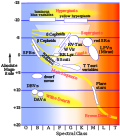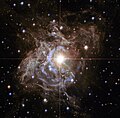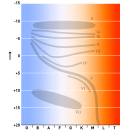The unqualified term instability strip usually refers to a region of the Hertzsprung–Russell diagram largely occupied by several related classes of pulsating...
8 KB (961 words) - 05:39, 13 November 2023
on a section of the diagram called the instability strip. Cepheid variables also fall on the instability strip, at higher luminosities. The H-R diagram...
23 KB (2,771 words) - 20:37, 11 May 2024
S Doradus (section The instability strip)
lie along a diagonal band in the H–R diagram called the S Doradus Instability Strip, with the more luminous examples having hotter temperatures. The standard...
28 KB (3,158 words) - 19:13, 15 January 2024
Blue loop (section Instability strip)
cross the instability strip during a blue loop are thought to become W Virginis variables. More massive stars, crossing the instability strip during a...
8 KB (1,038 words) - 13:56, 24 May 2024
secular redward (lower temperature) evolution across the Cepheid instability strip, but it may be due to interference between the primary and the first-overtone...
49 KB (4,701 words) - 15:52, 31 May 2024
composition. A nearly vertical region of the HR diagram, known as the instability strip, is occupied by pulsating variable stars known as Cepheid variables...
60 KB (6,813 words) - 07:50, 7 April 2024
hypergiants occupy a region of the Hertzsprung–Russell diagram above the instability strip, a region where relatively few stars are found and where those stars...
28 KB (3,354 words) - 16:31, 15 May 2024
star (IMS) first evolves away from the main sequence, it crosses the instability strip very rapidly while the hydrogen shell is still burning. When the helium...
40 KB (3,954 words) - 05:28, 12 December 2023
the instability strip and were originally referred to as dwarf Cepheids. RR Lyrae variables have short periods and lie on the instability strip where...
37 KB (4,170 words) - 19:48, 20 April 2024
temperatures, some becoming unstable pulsating stars in the yellow instability strip (RR Lyrae variables), whereas some become even hotter and can form...
49 KB (6,408 words) - 15:52, 29 May 2024
stars are the RV Tauri variables, AGB or post-AGB stars lying on the instability strip and showing distinctive semi-regular variations. Red supergiants develop...
33 KB (4,223 words) - 10:03, 17 May 2024
can cause it to become a variable star. An example of this is the instability strip, a region of the H-R diagram that includes Delta Scuti, RR Lyrae and...
29 KB (1,594 words) - 23:40, 3 May 2024
luminosity over time due to instabilities within their interiors, but these are small except for two distinct instability regions where luminous blue...
39 KB (4,440 words) - 17:10, 1 June 2024
Planetary nebula Protoplanetary Wolf-Rayet nebula PG1159 Dredge-up OH/IR Instability strip Luminous blue variable Stellar population Supernova Superluminous...
10 KB (1,141 words) - 11:39, 7 May 2024
unstable, leading to the instability strip on the HR diagram where the majority of stars are pulsating variables. The instability strip reaches from the main...
16 KB (2,321 words) - 14:49, 20 April 2024
types of variables amongst the supergiants are well defined. The instability strip crosses the region of supergiants, and specifically many yellow supergiants...
39 KB (5,309 words) - 00:06, 1 June 2024
known periods range between 5 and 23 minutes. They lie in the δ Scuti instability strip on the main sequence. The first roAp star to be discovered was HD...
8 KB (881 words) - 18:48, 8 February 2024
group consists of several kinds of pulsating stars, all found on the instability strip, that swell and shrink very regularly caused by the star's own mass...
50 KB (6,468 words) - 06:01, 22 April 2024
yellow supergiants are in a region of the HR diagram known as the instability strip because their temperatures and luminosities cause them to be dynamically...
20 KB (2,525 words) - 13:10, 29 May 2024
cluster has no stars in this region of its CMD. The gap occurs at the instability strip, where many pulsating stars are found. These pulsating horizontal-branch...
14 KB (1,722 words) - 16:03, 7 September 2023
Cardoso; Paolo Pani; Mariano Cadoni; Marco Cavaglia (2008). "Ergoregion instability of ultra-compact astrophysical objects". Physical Review D. 77 (12):...
13 KB (1,335 words) - 15:59, 26 May 2024
dwarf binary system with a carbon-oxygen accretion disk. G 117-B15A Instability strip Stellar pulsation Koester & Chanmugam 1990, p. 891–895. Murdin, Paul...
18 KB (1,988 words) - 06:32, 27 January 2024
Upper portion of H-R Diagram showing the location of the S Doradus instability strip and the location of LBV outbursts. Main sequence is the thin sloping...
16 KB (1,294 words) - 10:16, 6 March 2024
massive than the sun cross the Cepheid instability strip, called the first crossing since they may cross the strip again later on a blue loop. In the 2...
29 KB (3,699 words) - 23:28, 24 March 2024
region of the Hertzsprung–Russell diagram known as the S Doradus instability strip, where the least luminous have a temperature around 10,000 K and a...
38 KB (4,701 words) - 19:40, 17 February 2024
Planetary nebula Protoplanetary Wolf-Rayet nebula PG1159 Dredge-up OH/IR Instability strip Luminous blue variable Stellar population Supernova Superluminous...
7 KB (415 words) - 21:15, 17 April 2023
Planetary nebula Protoplanetary Wolf-Rayet nebula PG1159 Dredge-up OH/IR Instability strip Luminous blue variable Stellar population Supernova Superluminous...
5 KB (521 words) - 19:51, 3 May 2024
O'Brien, M. S. (2000). "The Extent and Cause of the Pre–White Dwarf Instability Strip". The Astrophysical Journal. 532 (2): 1078–1088. arXiv:astro-ph/9910495...
163 KB (18,571 words) - 01:18, 16 May 2024
exhausted their fuel and likely exploded in extremely energetic pair-instability supernovae. Those explosions would have thoroughly dispersed their material...
35 KB (3,540 words) - 20:01, 21 May 2024
result from the death of very large stars as pair-instability supernovae (or pulsational pair-instability supernovae). However, recent research by astronomers...
31 KB (3,266 words) - 05:08, 2 May 2024


















